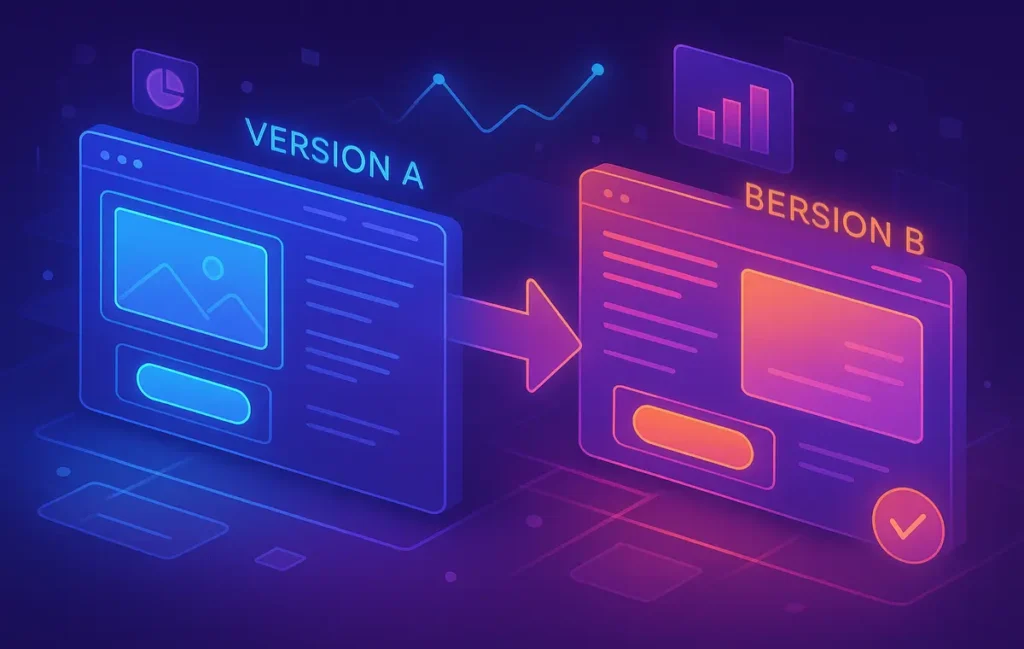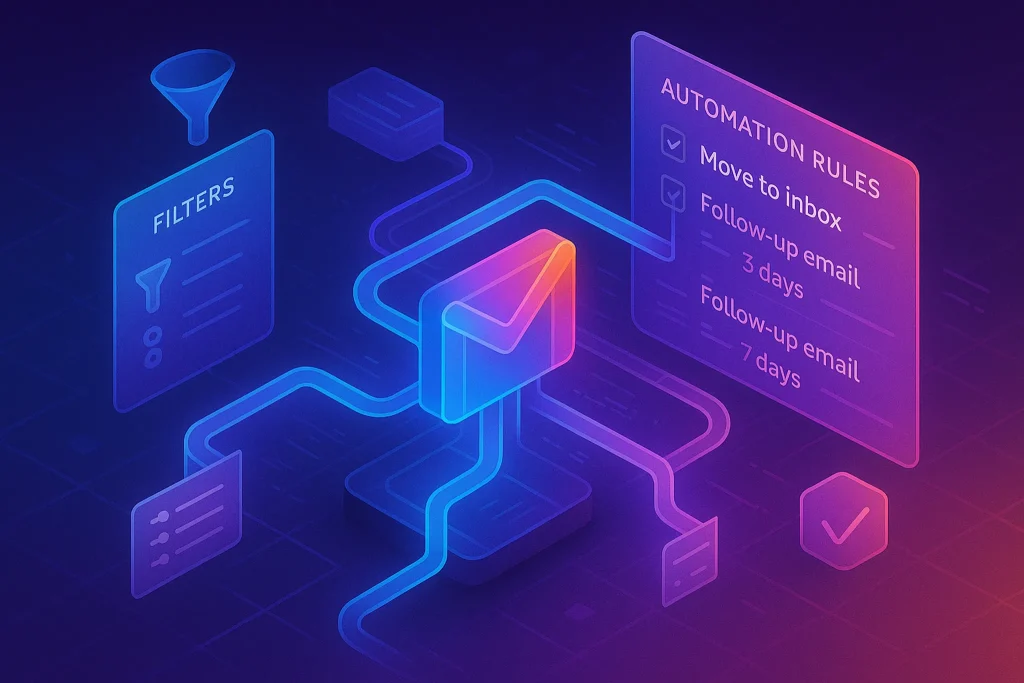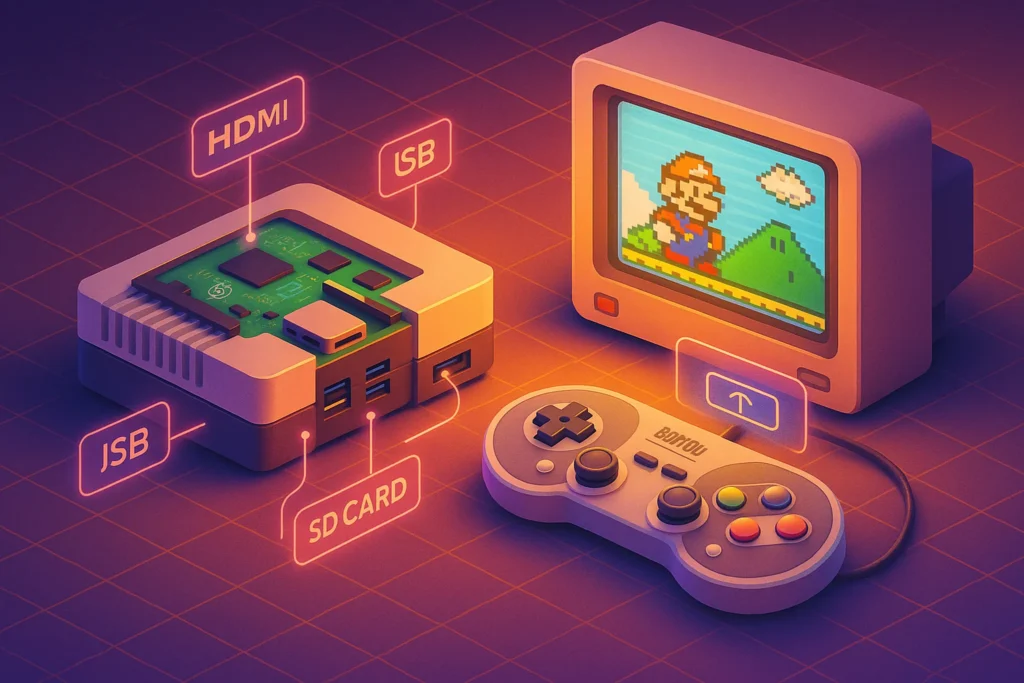🎯 Introduction: Why A/B Testing Isn’t Just for Big Companies
For many beginners, A/B testing feels like a luxury reserved for massive tech firms with endless traffic. The truth? It’s one of the simplest, most practical ways to improve results—even if you’re running a solo blog or a small e-commerce store. A/B testing lets you move past guesswork and base decisions on evidence. Imagine doubling your newsletter sign-ups just by changing the wording of your call-to-action. That’s the power of structured experiments, and it’s available to everyone.
💡 Nerd Tip: A/B testing isn’t about testing random things—it’s about learning what truly resonates with your audience.
📖 What is A/B Testing (in Plain English)?
At its core, A/B testing is a method of comparing two versions of something to see which performs better. You create a baseline (Version A) and a variation (Version B), then show both to segments of your audience. The goal? Identify the winner based on a key metric like clicks, conversions, or sign-ups.
For example, imagine you run an online shop. You want to know whether “Shop Now” or “Get Yours Today” gets more people to click your product button. An A/B test randomly shows half your visitors one button, and the other half a different one. After enough traffic, you’ll know which CTA actually drives action.
A/B testing is not reserved for landing pages—it applies to emails, ads, product pages, even video thumbnails. At NerdChips, we see it as the entry point to data-driven growth.
🧪 The A/B Testing Process: From Hypothesis to Win
The beauty of A/B testing is that it follows a repeatable framework. Beginners who follow this sequence avoid most rookie mistakes.
Step 1: Identify the problem or opportunity.
Look at your analytics. Is your bounce rate too high? Are people opening emails but not clicking? These pain points are perfect test opportunities.
Step 2: Formulate a hypothesis.
Don’t just say, “Let’s change the button color.” Say, “Changing the button color to green will increase clicks because it contrasts better with the background.” A hypothesis gives direction.
Step 3: Design the variants.
Keep it simple: one clear difference between A and B. That’s how you isolate the impact of the change.
Step 4: Run the test.
Split your audience randomly and let the test run until you have statistically meaningful data. Cutting early can lead to false positives.
Step 5: Analyze the results.
Review whether the variation achieved significance. Look beyond surface metrics. Did the change increase sales, or just clicks?
Step 6: Implement the winner.
Roll out the winning version, but don’t stop testing. Each win leads to the next hypothesis, and the cycle continues.
💡 Nerd Tip: Think of A/B testing as a loop, not a one-off experiment.
The process of forming a hypothesis, building variants, and analyzing results is structured but can feel overwhelming at first. To simplify the journey, we created A/B Testing Made Easy—a walkthrough that strips away jargon and focuses on quick wins beginners can implement without heavy analytics.
💡 Common A/B Test Ideas for Beginners
If you’re new, don’t overcomplicate things. The most impactful first tests usually come from elements your audience interacts with the most.
Headlines are a classic starting point—changing a single word can lift conversions by 10–20%. Calls-to-action (CTAs) are another easy win; sometimes “Download Free Guide” beats “Learn More” by a wide margin. Button colors and placements, email subject lines, and landing page layouts are also beginner-friendly test variables.
💡 Nerd Tip: Always test the elements closest to conversion, not cosmetic changes hidden deep in your site.
Once you’ve tested simple elements like headlines and CTAs, you can expand experiments into richer media formats. Video is one of the best playgrounds because small tweaks—like a thumbnail design, opening hook, or even total video length—can dramatically shift engagement. In our guide on A/B Testing Your Video Content, we break down how subtle visual changes can lift CTR and watch time.
⚙️ Best Tools for Easy A/B Testing
While Google Optimize has sunset, alternatives have become beginner-friendly and affordable. Tools like VWO and Optimizely remain industry standards, but smaller businesses often find ConvertKit A/B and Mailchimp testing features easier to adopt.
For those running landing pages, services like Unbounce or Instapage include built-in testing modules. The key is choosing a tool that integrates seamlessly with your existing workflow. If you’re running email-heavy campaigns, test inside your ESP. If you’re focused on ads, use testing directly within platforms like Meta Ads or Google Ads.
💡 Nerd Tip: Don’t chase tools with features you don’t need. Start with the simplest platform that fits your channel.
Running a test is only half the battle—analyzing the outcome with reliable data is where the real insight lies. For small teams, enterprise-grade analytics platforms may be too costly, but there are plenty of budget-friendly options. In Affordable Analytics Tools for Small Businesses we highlight tools that help you track, compare, and learn from your A/B results without breaking the bank.
⚠️ Pitfalls Beginners Should Avoid
The number one mistake is stopping a test too early. You might see a quick spike, but without enough sample size, that spike is often random noise. Another trap is testing too many things at once. If you change your headline, button, and image simultaneously, you’ll never know which element made the difference.
Finally, don’t fall into the vanity metric trap. A headline might improve click-through rate but reduce final conversions. Always anchor your tests to real business outcomes, not surface-level engagement.
💡 Nerd Tip: Pick one metric that matters most, and ignore the noise around it.
A large number of A/B tests happen within paid ad campaigns, since PPC delivers fast feedback loops. But without proper campaign management, your test data can be noisy or even misleading. Our breakdown of Top PPC Management Tools shows how the right platforms streamline testing, attribution, and optimization for every ad dollar.
📊 Case Study: Small Change, Big Win
One SaaS startup ran an A/B test on their free trial landing page. The only change? Switching the CTA button from “Start Free Trial” to “Get Started in 30 Seconds.” The result was a 17% increase in sign-ups, purely by highlighting speed and simplicity.
The lesson: the smallest tweaks, when tied to user psychology, can unlock huge gains. This is why even beginner-friendly A/B testing is worth the effort.
The reason a tiny tweak can create such a measurable lift isn’t luck—it’s data. When your creative choices are backed by analytics, every test becomes a learning opportunity. Our article on Data-Driven Content explores how blending creativity with evidence ensures your A/B tests don’t just produce wins, but repeatable growth patterns.
⚡ Ready to Build Smarter Workflows?
Explore A/B testing tools like VWO, Optimizely, and ConvertKit Experiments. Start optimizing in minutes—no coding, just learning from data.
🧠 The Psychology Behind A/B Testing
A/B testing works because people are wired to respond differently to small environmental cues—even if they don’t consciously notice them. For beginners, it’s important to understand that these tests aren’t about tricking users; they’re about aligning design and messaging with natural human tendencies.
One major concept is loss aversion. People often act more strongly to avoid losing something than to gain something. A CTA that says “Don’t miss your free trial” may outperform one that simply says “Start your free trial.” Similarly, color psychology plays a role—green may signal “go” or progress, while red might create urgency. These aren’t universal truths, but they create strong starting hypotheses.
Another psychological driver is social proof. When landing pages highlight “10,000+ people already signed up,” conversions often jump because people trust what others are doing. And finally, there’s decision fatigue: too many options can paralyze visitors. Sometimes the winning test variation is simply the cleaner, simpler design.
💡 Nerd Tip: The best A/B tests aren’t random guesses; they’re experiments built on principles of how people think, feel, and decide.
📊 Statistical Confidence & Sample Size
One of the biggest beginner mistakes is declaring a winner too soon. Just because variation A is “leading” after 50 visits doesn’t mean it will keep winning at 500 or 5,000 visits. That’s where statistical confidence comes in.
Statistical significance is a way of measuring whether your test results are likely due to real differences or just random chance. Most marketers aim for at least 95% confidence, meaning they’re 95% sure the winning variation really is better. Achieving this requires a large enough sample size—often a few hundred or even thousands of interactions depending on your traffic.
The good news is you don’t have to calculate this manually. Free calculators and built-in testing tools estimate how long you should run a test before declaring a winner. The golden rule: never stop early just because you’re excited. Doing so risks basing your strategy on noise instead of data.
💡 Nerd Tip: Patience is part of testing. Let the data mature before making calls—your long-term ROI depends on it.
🔄 Beyond A/B: Multivariate & Sequential Testing
While A/B testing is the perfect starting point, it’s not the end of the road. Once you’ve mastered the basics, you’ll encounter multivariate testing, which compares multiple elements (like headline + CTA + image) simultaneously. This helps uncover interactions between design choices but requires much more traffic to reach significance.
Another advanced option is sequential testing or bandit testing. Instead of splitting traffic evenly until the end, these methods dynamically adjust traffic allocation toward the variation performing best in real time. The result? Faster learnings and less wasted traffic.
Even if you don’t dive into these methods yet, understanding they exist gives you a roadmap. Today, A/B testing teaches you the basics of controlled experiments. Tomorrow, advanced testing unlocks even deeper optimization possibilities.
💡 Nerd Tip: Think of A/B testing as learning to crawl, multivariate as walking, and adaptive testing as running. Each step builds on the last.
🌐 Cross-Channel Testing Insights
One of the myths about A/B testing is that it only applies to websites. In reality, you can test nearly every channel where customers interact with your brand.
In email marketing, subject line variations are classic tests—sometimes changing just one word can increase open rates by 10% or more. In social media, you might test the same post with two different images to see which earns more shares. PPC ads benefit enormously from structured A/B testing; Google Ads and Meta Ads even have built-in split-testing features. And for creators, A/B testing applies to YouTube thumbnails, video intros, and even length of content.
This multi-channel approach ensures you’re not just optimizing one touchpoint but improving the entire journey. When beginners realize the universality of testing, they stop thinking of it as a “website-only tool” and start seeing it as a growth engine across platforms.
💡 Nerd Tip: Don’t silo your experiments. Insights from an email test can inspire your next landing page test, and vice versa.
💬 Real User Voices
Sometimes the most convincing lessons don’t come from theory or frameworks but from the trenches. Marketers and creators frequently share their A/B testing wins and fails on X (formerly Twitter), and these raw insights can inspire your own experiments.
One growth marketer shared that switching a CTA button from “Buy Now” to “Get Started Free” lifted conversions by 18%—simply because the latter felt less risky. Another reported that shortening a sign-up form from five fields to three nearly doubled completion rates. On the flip side, a SaaS founder admitted they wasted weeks testing a banner color change that had no meaningful impact because the sample size was too small.
These stories remind us that A/B testing is equal parts science and humility. Wins can be surprisingly easy, but false positives are just as common. By learning from other practitioners’ experiences, you can avoid pitfalls and focus on meaningful tests.
💡 Nerd Tip: Follow experienced marketers who share their experiments. You’ll build a backlog of test ideas without starting from zero.
Want More Smart AI Tips Like This?
Join our free newsletter and get weekly insights on AI tools, no-code apps, and future tech—delivered straight to your inbox. No fluff. Just high-quality content for creators, founders, and future builders.
100% privacy. No noise. Just value-packed content tips from NerdChips.
🧠 Nerd Verdict
A/B testing isn’t a mysterious science for big corporations—it’s the fastest, most affordable path to data-driven growth for anyone. By starting with a simple hypothesis, running structured tests, and committing to continuous improvement, even small businesses can make smarter decisions and win more conversions. At NerdChips, we believe testing is not just a tactic, but a mindset shift: from guessing to learning.
❓ FAQ: Nerds Ask, We Answer
💬 Would You Bite?
If one simple A/B test could boost your sign-ups by 15%, what would you test first—your headline, your call-to-action, or your email subject lines?
Crafted by NerdChips for creators and teams who want their best ideas to travel the world.



